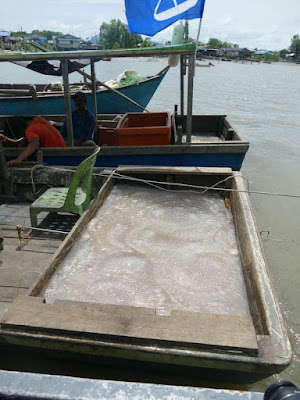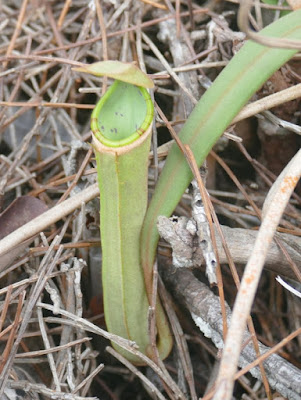A lot of people these days seem to visit Malaysian Borneo, with their focus mostly on Sabah - mighty Mount Kinabalu, the Orangutan and Sun Bear rehabilitation centres at Sepilok, the grim Second World War sites at Sandakan and Kundasang and perhaps the caves at Gomantong where swiftlet nests are still harvested for bird-saliva soup. All of these places, and more, are worthy of our focus and I'll doubtless be introducing most of them here in due course.
Today however I want to go west from Sabah, to the less-visited state of Sarawak, and an often-overlooked but delightful little national park on a South China Sea peninsula just 40km from the state capital Kuching. It is relatively popular as a day destination from Kuching, but I would
highly recommend an overnight stay in the basic but quite adequate
cabins; a restaurant provides all meals.
 |
| Bako National Park, the oldest in Sarawak (gazetted in 1957) is indicated by the red arrow. |
After arriving at the little port of Kampung Bako ('kampung' meaning a village), we take to small boats to travel a short distance down the Bako River, then along a spectacular sandstone coastline where the rainforest comes down to the sea.
 |
| Boat returning from the sea with a catch of jellyfish; perhaps surprisingly there is a big market in jellyfish for consumption in other parts of Asia. |
 |
| Part of the catch; tentacles are cut off before the animals are taken on board. |
 |
| Above and below, the rainforest comes right to the sea among weathered sandstone stacks. |
The landing is among mangroves, with a board walk for the short distance to the accommodation, scattered around a clearing in the rainforest, just above the beach.
 |
| View from the landing of the beach and headland that fronts the accommodation. |
 |
| Close-up of headland at the end of the beach. |
The cabins (quite a few of which were closed, presumably for upgrading, when we were there in May 2016) are set into the forest edge and wildlife is prolific.
 |
| Typical cabin, run by the parks service. |
The most immediately obvious residents are the Bearded Pigs Sus barbatus and the Long-tailed Macaques Macaca fascicularis, both of which forage around the complex.
 |
| The pigs, native to Peninsular Malaysia and adjacent islands including Borneo and Sumatra, are content to keep their distance and wait for pickings. |
Many less intrusive animals are present however - birding in Borneo can be quite a challenge, but around the cabins at Bako it can be easier than in some other sites. Even before them however, there are animals along the mangrove boardwalk when first you disembark.
 |
| Fiddler Crabs challenge each other with an enlarged claw whose sole purpose is for display - it is non-functional as far as feeding is concerned. |
 |
| Hermit Crabs, protected by scavenged sea snail shells, also roam the mud flats. |
 |
| Mudskippers, re-enacting the drama of life moving ashore, are among the welcoming committees. |
 |
| Mangrove Skink Emoia atrocostata on the sand at the landing. This widespread skink specialises in coastal habitats on islands throughout the western Pacific and in Queensland. |
Reptiles are quite evident throughout any stay at Bako in fact.
 |
| Green Crested Lizards Bronchocela cristatella are incredibly agile, skipping through tree foliage, and hurling themselves out into space. |
In addition to the macaques, two other monkey species are present, neither of which are interested in interacting with humans.
Perhaps the stars however are the Proboscis Monkeys, endemic to Borneo. Most people see habituated Proboscises at feeding stations, but Bako is an excellent place to see them in the wild.
 |
| The huge gut is a vat for digesting leaves through bacterial action (like a ruminant mammal) but in fact Proboscis Monkeys also eat a lot of more readily digestible fruit. |
For those with a particular interest in mammals, another resident is of at least equal interest.
And so to the birds - just a few sample species here of the many present.
 |
| Red-crowned Barbets Psilopogon rafflesii can be seen wherever trees are fruiting. |
 | ||
| Asian Fairy-bluebird Irena puella; a member of a family of just two Asian fruit-eaters. This one is found across southern Asia, the other just in the Philippines. |
 |
| The Oriental Dwarf Kingfisher Ceyx erithaca is a tiny (13cm) forest kingfisher. |
 |
| Blue-throated Bee-eaters Merops viridis sit out in the open watching for insects, often near the sea. |
All of these can be found in the lowland rainforest and clearings close to the accommodation, but an only moderately strenuous short climb up a formed track to the plateau above leads to a different world. This is the kerangas, a heathy low-growing forest which subsists on low-nutrient acidic sands (the name is based on a local word meaning 'land where rice cannot grow'!). This habitat tends to be lower in animal diversity but is nonetheless fascinating, and is notable for pitcher plants, insect-eating plants which supplement their otherwise low nitrogen intake thus. They will surely be getting their own posting here soon!
 |
| Looking out towards Santubong Island, from where Alfred Russel Wallace purportedly wrote an historic letter to Charles Darwin. |
 |
| Nepenthes albomarginata; the white rim below the mouth of the pitcher has been shown to attract termites to their doom in the liquid. (The rim on this one is fading to brown.) |
The ant plants - various species which employ ants to bring them food in the form of droppings and other food waste, in exchange for shelter in hollow structures - are also found in this low-nitrogen habitat.
 |
| Myrmecodia sp. (Family Rubiaceae), an epiphytic ant plant growing on a tree trunk. They are abundant in the kerangas; the holes in the woody bulb where the ants enter are clearly visible. |
Dischidia species, twiners in a quite separate family, Apocyanaceae, pursue similar aims by different methods. They have two quite different types of leaf - 'normal' fleshy leaves, as can be seen in the photo above growing around the unrelated ant plant, and larger enclosed leaves which accumulate nutrient within, and which offer shelter to foraging ants.
 |
| 'Ant accomodating' Dischidia leaves. |
As I said, a fascinating habitat indeed, and one which you might like to contemplate with a drink down by the sea again, while you watch the sunset over the South China Sea.
As I hope I also said, Bako is a bit special, and you could do much worse than visiting it as your introduction to Borneo.
BACK ON WEDNESDAY











No comments:
Post a Comment